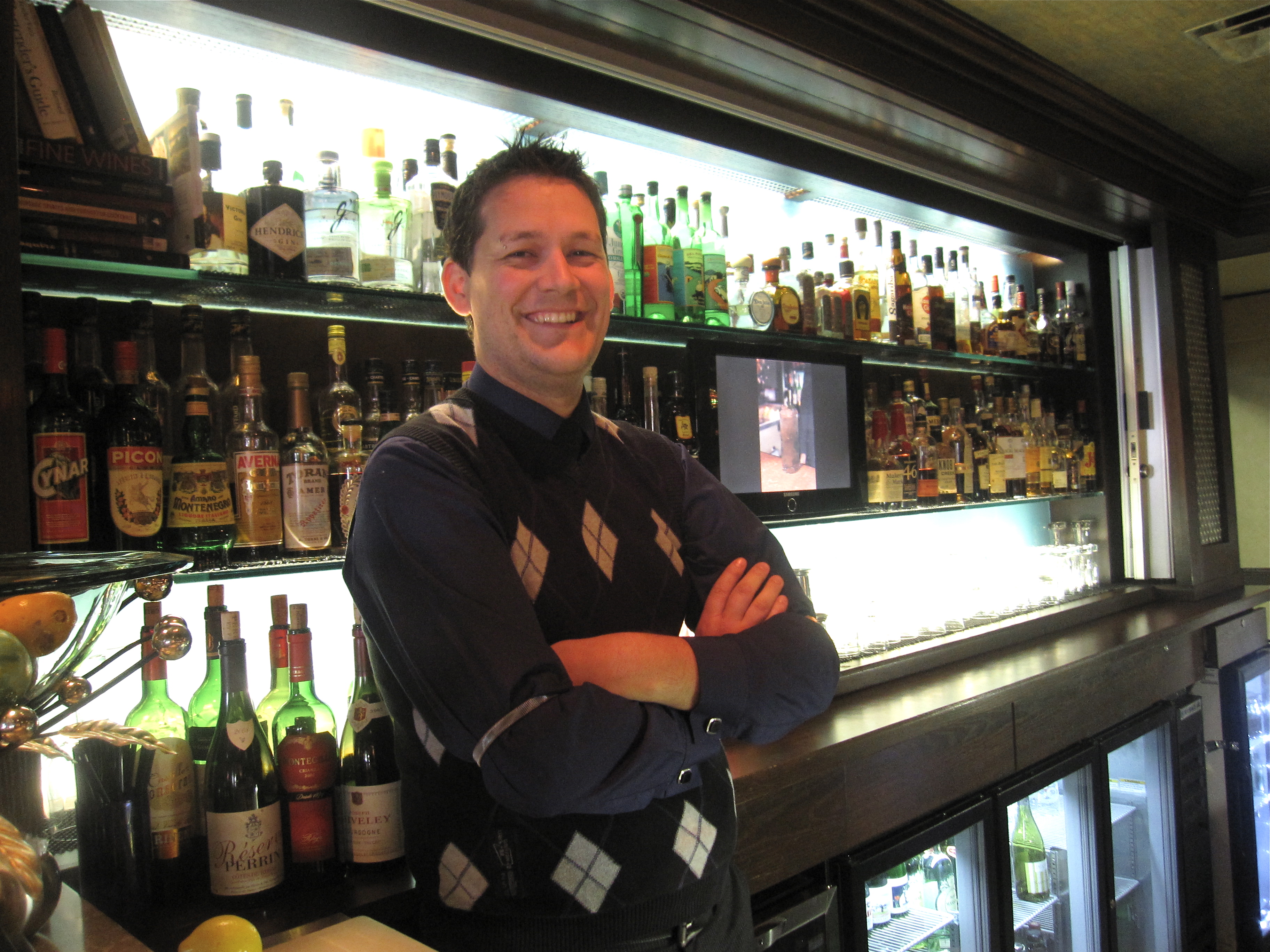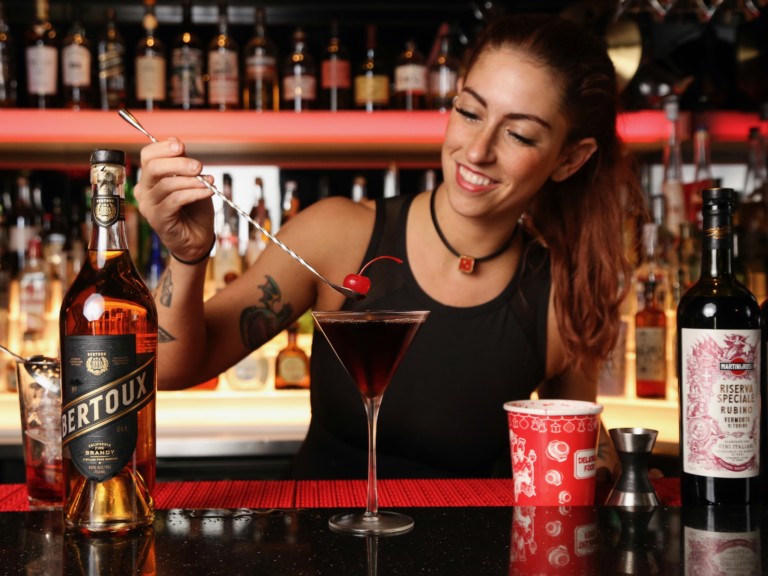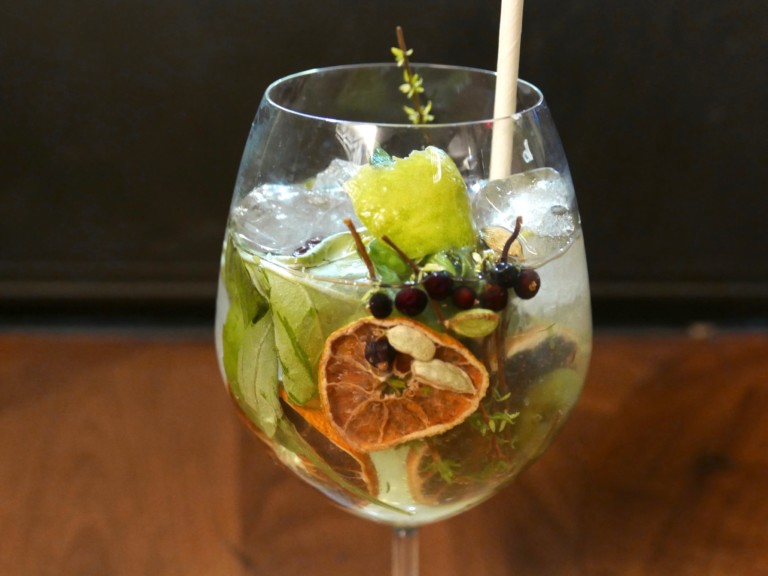When Shawn Soole arrived in Victoria, the award winning bartender from Brisbane, Australia, had a lot of work to do. He’s spent the past two years transforming a British style pub in downtown’s Chateau Victoria into a cocktail bar with a classic base, a number of house-made ingredients and even a barrel aged cocktail program. Now, Clive’s has developed a reputation beyond the Canadian border. We recently joined Soole at the bar, and he better explained his background and approach.
What brought you to Victoria?
You’ve seen Victoria. It’s gorgeous. Victoria’s cocktail scene and bar culture was just like Madonna, washed up, but people are taking a little more time and effort with it, and we’re slowly but surely – in the two years I’ve been here – it’s changed a lot. People are moving on to doing better cocktails. It’s funny. In Victoria, it’s the weirdest thing in the world. Coffee, beer and wine are really big, and so is food, but cocktails have always taken a backseat. People will wake up in the morning and go have a coffee at one of the local roasters, and pay two-fifty, three bucks for a latte, go have lunch at Pink Bicycle, which does all island-grown meat, and do a really nice hamburger with a local beer, then go on to Brasserie L’ecole, a wicked restaurant in town, and do local wine, and local pork, and stuff like that. Then they’ll go to a bar and say, “Give me a Cosmo, with cranberry juice out of a gun. I’m happy with that.” Cocktails here aren’t a big thing, but slowly and surely we’re gaining. We’ve been spoiled this year, for us at Clive’s, we’ve been in New York Times and stuff like that, so we’ve got a lot of national success, which has sort of driven people to come here and try it out. It forces people, when they go somewhere else and have a sub-par one, it sort of pushes everyone to do it better. So I’ve got restaurants coming to me, looking to do consulting and stuff like that. I do it all for free.
Oh really?
Yeah. I’ve done training and cocktail lists for two restaurants, and do it all for free, just for the pure fact that if there’s more people doing it, it just builds the culture. All the seminars we do here are free. Everything is as free as possible, just for the pure fact that I want people to get what we’re doing.
What inspired your initial interest in cocktails and spirits?
I fell into it. I was 16, 17, and I was assistant handyman at a hotel. They were like, “Do you have whites at home?” “Yeah.” “Do you want to work a wedding tonight?” “Okay.” That’s what my introduction to food and beverage was, and they had me work the bar for a night at another wedding. From then, I was sort of food and beverage all the way. I’ve been doing this close to 15 years now.
What was the hotel?
Albert Park Hotel.
In Brisbane?
Yeah. It was a dodgy little hotel. I was landscaping, doing basic maintenance, and as a 16, 17 year old kid, fell into it.
When did you know that you worked with cocktails for a living?
20, 21. I worked my first state finals when I was 21. After that, I was done. I bounced around Brisbane a lot, popped up to the Great Barrier Reef and then came over here, and when I came over here, I realized there was no cocktail culture at all, so I got into wine a lot. I got my sommelier’s certificate, and when they opened this place, they scouted me about six months later and said, “We want a classic style, pretty much a 1930s, 1940s, European-style hotel bar. Can you do this for us?” “Yeah. You’re a British pub right now, and you want a European-style hotel bar. I can do it, but it’s going to take a hell of a lot of work.” 80 hours a week for 18 months, or two years later, we’re where we are now.
Are you where you want to be?
Still no. I think I’m always finding new things, whether it be one spirit behind the bar that I want to get rid of. We’re a hotel, so we have to be careful with companies we have different contracts with, and stuff like that. The ice we’re using is not up to the par that we want, or we want a whiskey wall put in. We never rest on our laurels. None of the staff do. We always want to be that one step better. Once we get a certain thing, we want to be one better.
Did you become interested in cocktails or spirits first?
Cocktails always interested me. I worked at them on Sundays. I always used to geek out. I’m still young. I’m only 30 and turn 31 in six months time. I’m still young, but in Australia, or pretty much anywhere outside of New York or San Francisco, cocktails have only been going for like 10 years, so when I started off in cocktails, there was no one who you’d go to, or looked up to. You had your Angus Winchesters from London, and your Peter Dorellis, and your Salvatore Calabreses and stuff like that, but there were no Jim Meehans or Sasha Petraskes. None of these guys were big names then. You had this small little clique of people you could look up to, like Simon Difford, so you really had to self-teach yourself, because then, there weren’t really any bartenders standing above anybody.
Everybody was still working at nightclubs, and the cocktail bars that were passing themselves as cocktail bars were still serving Cosmos and stuff out of a gun, and quick, easy things. They thought they were being really cutting-edge, which at the time they were, but nothing that was one step above, or two steps above. So you really had to self-teach yourself, read through tons of books. I still have 150 cocktail books stored in Australia that I can’t bring over because it’s too expensive to ship, that I collected over a decade in Australia.
Do you have a very first cocktail memory, good or bad?
A bad one, actually. Someone came to the bar and asked for a classic gin martini and I said to one of the other bartenders, “I have no idea, you take it.” I was looking through a 1970s cocktail book and it just looked too imposing, so I said, “I can’t do this,” and just left, and let someone else do it for me. Slowly but surely I watched people at bars, when I was there, and drank more cocktails, and started doing more.
Has this space stayed with the ’30s, ’40s cocktail base?
We’ve definitely got a classic cocktail base. If you look through our list, we’ve got Lungo Italiano, which is our Italian inspired drinks. We were Canada’s first Campari Red Bar, which is a thing you get from the Campari office in Italy that says you pour the best drinks with Campari. Nobody knew what it was in Canada until we got the listing. We do a lot of Amari, Cynar Americano, we make the Fernadito, which is Fernet Branca topped with our house-made cola. We make cola in-house, from scratch, so it’s an Argentinean style classic…We’ve cut back on our classic selection, not to the point of a bad thing. We’ve cut it back because we’ve started removing Sazeracs and Old Fashioneds and just calling the category Martini to Manhattan. When you walk into a bar, you should hopefully be able to get a good martini or Manhattan, regardless of where you are, but we serve Manhattans, Sazeracs, Aviations, Clover Clubs. Stuff like that sort of falls into the same category. So when you come here and order a Clover Club, you’ll get it.
Is there any cocktail that’s untouchable on the menu?
There’s one from me and Nate, my second bartender, we work Friday, Saturday and Sunday, we work all the time together, on the Intense Idealogy page, it would be the Cocktail a la Louisiane, which is a cocktail from the 1930s, from Stanley Clisby Arthur’s book, How to Mix ‘Em. It’s a wicked cocktail. It’s like if a Sazerac and a Manhattan had a love child, that’s what it would taste like. The Toronto, the next one down, is the next big one for me. It’s a classic Canadian cocktail, obviously, and we do barrel aged Torontos as well. A Toronto will probably always be on the menu, but we’re getting so well known.
How come you like working with Italian style cocktails? That seems to be becoming more popular.
I don’t know why we do a lot of Italian stuff. We started off just with the basics, and then we sort of moved into Negronis, which has always beeen a popular one for me. We started exploring. We had a Trident on the menu for awhile, which is Aquavit, Cynar, Tio Pepe and peach bitters from Robert Hess. It’s from Seattle. And then we just started acquiring amari. We’ve got about 16 amari now, so we started getting OCD about it, and every time we saw a new amari, we were like, “Done, done, done,” and we’d just figure out a way to use it. We sell more Fernet Branca than anyone else in the country because we push it on the people who may not necessarily like Fernet Branca, but they try it and they’re like, “We love this.” They start sipping it. It’s not like in San Francisco when it’s all “Shot, shot, shot, shot, shot” from the bartending crew. Really, San Francisco’s a whole different culture for Fernet Branca than anywhere else. Here we have it on the rocks, and sip it with Coke. It’s really random. We pretty much have so much confidence with what we do that we can go, “You will like this,” and they’ll go, “Okay, make it for me.”
How many of your ingredients are you making in-house?
We make cola, five different styles of bitters, all our syrups, our olives, our onions, our cherries, a green tea infused amaro, we make Curacao in-house now. Cherry Heering’s made in-house. You can’t get Cherry Heering in Canada, so we’re like, “Okay, we’re going to make Cherry Heering. We’re going to make cherry brandy from scratch.” We make sure to buy really nice cherries, brandy and maraschino liqueur. Let it steep for a couple of weeks, put it through a food processor, double strain it and filter it through a coffee filter to get rid of the sediment. Then you have really nice cherry brandy. It’s different than the Cherry Heering. You put it in Singapore Slings and your Blood and Sands and it works really well. If you’re doing a more spirit forward cocktail, it would be different with Cherry Heering, but we work with what we’ve got.
We can’t get Curacao in B.C., so when the season came about, I peeled 30 pounds of Sevilla oranges, dried the peels, soaked them in brandy for a month, and then sweetened them up. So we have house-made Curacao, which makes a real nice Derby and nice Mai Tais and stuff like that.
What was the latest cocktail you put on the menu, and what was your approach with it?









Blog Comments
Book Pitch of Cocktail Cultures | Marketing for Publishing
September 8, 2013 at 4:11 PM
[…] Interview: bartender Shawn Soole (Clive’s):http://www.foodgps.com/qa-with-bartender-shawn-soole/ […]